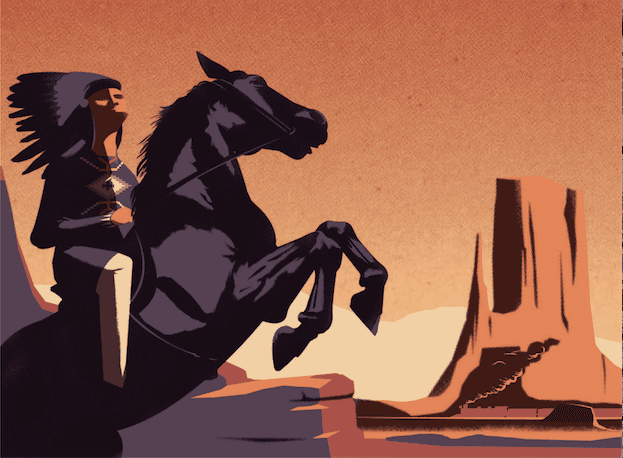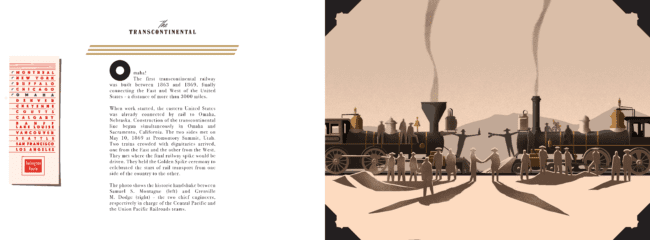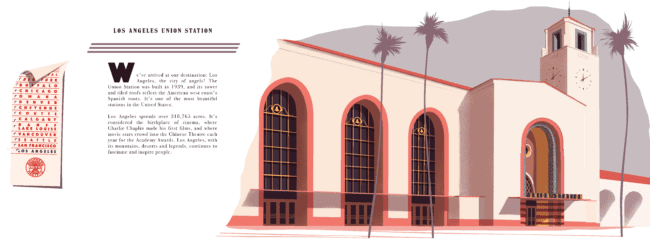If the devil is in the details, then Pascal Blanchet is the very devil himself. Known especially for his 1920s Art Deco artistic style with a whimsical twist, Blanchet’s work is a masterclass in simple elegance. Blanchet’s colorful geometric style is a feast for the eyes, mesmerizing the reader with block outlines and silhouettes, somehow giving just enough of a hint to suggest shape without a single line more. Simplistically color-blocked building facades create a riot of color that give way to such intricately woven details as a single archway, clock, or window, which become the heart of the image’s mastery. Blanchet creates breathless articulations of intricate natural and manmade landscapes that produce audible gasps of wonder from the reader.
Blanchet’s style lends itself especially well to his newest work Go West!: America by Railroad, Blanchet’s first foray into historical nonfiction. A departure from his more whimsical and nostalgic tales like La Fugue, White Rapids, and Nocturne, Blanchet presents the trans-American and Canadian landscape through a series of postcard-like images that encompass an epoch in a single image. As Chicago’s jazz scene, the Banff Springs Hotel, and the Golden Gate Bridge rise and fall with each turn of the page, the reader cannot help but be as entranced by the effortlessly rendered majestic landscapes as they are from the scrapbook photo corners holding the frame in place or the train ticket curling upwards from the page.
Written in a second person narrative, Blanchet is the conductor of a story-world that encompasses and educates the reader, ushering them along a cross-country journey through shifting time and space. Blanchet constructs both a nostalgic and futuristic view of the railway – a sort of bygone golden-age of exploration and industry often associated with the Titanic era or the space race. His images make the reader long for the luxurious sleeper cars, red carpets, and strawberry milkshakes in dining cars that seem to be erased from rail travel today. Blanchet encompasses the wonder associated with moving through country as opposed to over it by plane, and that this moving through space is as intricate a way of seeing place as it is people.
Though Blanchet’s tale celebrates some nearly two hundred years of rail history, it does not shy away from the conflicts that history is built upon. Canada and America’s fought history with trans-national railways created a national identity at the expense and detriment to a great number of peoples. Blanchet’s work demonstrates the exhilarating expansion of the West and the foundational spirit of Manifest Destiny in one image and in the next the decimation of the Native American peoples, their lands, and their food sources. In another sequence Blanchet depicts the railway’s interconnection to Black history, with railways in the 1800s hiring freed slaves to usher opulent and elegant luxurious rail travel which is then juxtaposed against the horrific working conditions faced by African-Americans. Blanchet’s work does not seek to present a single story of the rails, but to juxtapose different moments in its tumultuous history.
The rail, as Blanchet depicts it, is a key tool to nation building and progress, it shapes personal and national identity and reminds us how interconnected those two constructs are. The rail often functions as a boarder, while the very idea of its boundary-making ability is subverted. The rail crosses between America and Canada, North, South, East, West, time, space, and place. All of manner of people traverse and permeate this boarder, one of which is you, the reader. Blanchet’s cross-country foray reminds us that we are all active travelers on route to somewhere, together. Go West suggests that it is as important to see who and what is around us as it is to see what we’re travelling on, so we can understand where we’re going by knowing where we’ve been.










